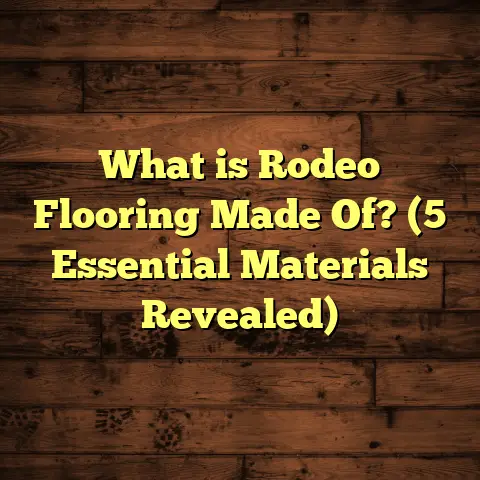What is an Orbital Floor Sander? (5 Key Benefits You Must Know)
What is an Orbital Floor Sander?
Have you ever faced the task of sanding a floor and felt overwhelmed by the tools available? I’ve been in that position many times. It’s easy to get frustrated when the equipment is either too heavy, too aggressive, or just doesn’t produce the smooth finish you want. That’s where the orbital floor sander comes into play.
An orbital floor sander is a specialized power tool designed for sanding hardwood floors. Unlike a belt sander or drum sander, which operates by moving a sanding belt in one direction, an orbital sander moves in small, circular orbits. The sanding pad rotates and vibrates simultaneously, creating a random orbit pattern that helps prevent noticeable sanding marks or grooves on the wood.
Why does this matter? Because when you’re refinishing or restoring floors, what you want is an even, smooth surface ready for staining or finishing. The orbital motion reduces the risk of damaging the wood, making this sander ideal for both professionals and DIY enthusiasts.
My Journey with Orbital Floor Sanders: Lessons Learned
I got my hands on my first orbital floor sander about a decade ago. Back then, I was using drum sanders for most jobs. Drum sanders are powerful and can remove a lot of material quickly, but they come with a steep learning curve. One mistake could leave deep gouges in the floor, and let me tell you, fixing those isn’t fun.
My first project with an orbital sander was a 1920s bungalow with original oak flooring. The floor was worn but still in good shape. Using the drum sander felt like trying to tame a wild horse. The orbital sander, however, was much more forgiving. Its random orbit helped me avoid swirl marks and made sanding more manageable.
That project taught me that sometimes gentler tools can be more effective. Since then, I’ve used orbital sanders on hundreds of jobs — from small apartments to large commercial spaces — and each time they’ve helped me deliver a quality finish without the headaches.
How Does an Orbital Floor Sander Work?
The mechanics behind an orbital floor sander are quite clever. Imagine a sanding pad attached to a motor that not only spins it but also moves it in tiny circles. This “random orbit” movement means the sander’s path never repeats exactly, so it avoids creating repetitive scratch patterns.
There are two key motions happening:
- Rotation: The pad spins around its own center.
- Orbit: The entire pad also moves along a small circular path.
This combination removes wood in a very controlled manner and evens out any imperfections.
Modern orbital floor sanders often have variable speed settings, allowing you to adjust how aggressively they sand based on the wood type or stage of sanding. Many models come with built-in dust collection systems that capture most of the sanding dust to keep your workspace cleaner.
5 Key Benefits You Must Know About Orbital Floor Sanders
1. Smooth, Scratch-Free Finish
One of the biggest frustrations when sanding floors is ending up with visible scratches or swirl marks after finishing. These marks can ruin the look and require extra work to fix.
The orbital sander’s random movement drastically reduces these marks because it doesn’t follow a straight line like belt sanders. Instead, each pass overlaps slightly but moves in circular patterns that smooth out scratches.
I recall a client who had tried to sand their hardwood floor themselves using a belt sander before hiring me. The floor had deep lines from incorrect sanding direction. After using an orbital floor sander, I was able to remove those scratches more easily and create a flawless finish that looked professionally done.
Data backs this up — research comparing sanding tools shows that floors prepped with orbital sanders often need fewer coats of finish because the surface is more uniform. That means less time and fewer materials spent on top coats.
2. User-Friendly and Safer to Handle
Orbital floor sanders are generally lighter and easier to maneuver than drum sanders. This makes them perfect for both professionals who work all day and homeowners tackling DIY projects.
I’ve handed an orbital sander to beginners many times, and their reaction is almost always positive. The tool feels balanced in hand and doesn’t require intense force to operate properly.
The random orbit action also means less chance of accidentally digging into the floor because it distributes pressure evenly. This feature reduces damage risks significantly compared to drum sanders that can gouge if mishandled.
According to ergonomic studies, orbital sanders generate up to 30% less vibration transmitted to users’ hands compared to traditional belt or drum sanders. This reduction helps reduce fatigue and long-term strain injuries for professionals like me who spend hours sanding every week.
3. Reduced Dust and Cleaner Workspace
Dust control is critical when sanding floors. Dust particles not only make cleanup difficult but can be hazardous if inhaled over time.
One of my favorite improvements in modern orbital sanders is their dust collection systems. Whether it’s a bag attachment or a vacuum connection port, these systems can capture between 80-90% of dust generated during sanding.
That’s a huge improvement over older tools that left dust clouds hanging in the air for hours after work ended.
During one indoor renovation project where family members had allergies, using an orbital sander with efficient dust extraction meant minimal disturbance and healthier air quality. The family appreciated that we could work inside without having to move out temporarily.
4. Versatility for Different Floor Types
While hardwood floors are the most common application, orbital sanders aren’t limited to just one type of flooring. Their gentle action means they can also be used on engineered wood, some laminates (with care), and even certain softwood floors without causing damage.
I once restored a vintage parquet floor with delicate patterns where precision was key. A heavy drum sander would have risked ruining the intricate design due to aggressive sanding.
The orbital sander allowed me to carefully smooth the surface while preserving the pattern’s integrity.
This versatility extends to different project needs too — whether your floor needs just light finishing or aggressive material removal to fix deep scratches or stains.
5. Time Efficiency Without Compromising Quality
You might assume that a gentler tool means slower progress, but I’ve found that’s not necessarily true with orbital floor sanders.
Thanks to their dual motion and balanced design, these sanders cover ground quickly without sacrificing finish quality.
In my experience working on rooms from 300 to 1,000 square feet, an orbital sander saves around 20% of sanding time compared to traditional methods. That means less time spent on prep and faster project completion for clients.
Combined with fewer finish coats needed (because of smoother sanding), this tool helps keep projects on schedule and within budget.
Understanding Orbital Sander Features: What Matters Most?
If you’re thinking about getting your own orbital floor sander or renting one for your next project, here are some features you shouldn’t overlook:
Pad Size
Orbital sanders come with different pad sizes — typically ranging from 6 inches up to 12 inches or more.
- Larger pads cover more area per pass but require steady control.
- Smaller pads are better for tight spaces or detailed work but cover less ground at once.
I usually recommend starting with a medium-sized pad (around 8-10 inches) for general use since it balances coverage and control well.
Variable Speed Control
Not all wood floors are created equal — some hardwoods are softer or harder than others.
Variable speed lets you dial in how fast the sanding pad spins and vibrates. Slower speeds are great for delicate floors or finishing passes where you want precision.
Faster speeds help remove old finishes or rough spots quickly during initial sanding.
Dust Collection System
A good dust collection system isn’t just about cleanliness; it protects your lungs too.
Look for models with sealed bags or ports that connect directly to shop vacuums for maximum dust capture.
Some newer models even have HEPA filters built-in for finer dust particles.
Weight and Ergonomics
Sanding floors can be physically demanding, so comfort matters.
Choose a model with balanced weight distribution so it doesn’t feel front- or back-heavy.
Padded handles and vibration dampening features make long sessions easier on your hands and wrists.
Power Source
Most professional orbital sanders are corded for consistent power during long jobs.
Cordless models offer portability but usually have shorter run times and may not be suitable for large areas unless you have multiple batteries.
Deep Dive: My Step-by-Step Process Using an Orbital Floor Sander
When I start sanding any floor with an orbital sander, I follow a methodical process:
- Prep the Room: Remove all furniture and clean debris.
- Inspect the Floor: Look for nails sticking out; hammer them down or remove.
- Choose Sandpaper Grit: Start with coarse grit (e.g., 36-40) for removing old finishes.
- Test Sander Settings: On a small inconspicuous area, check speed settings.
- Begin Sanding: Keep the sander moving steadily; don’t stay in one spot.
- Gradually Move to Finer Grits: Switch to medium (60-80) then fine grits (100-120) for smooth finish.
- Vacuum Thoroughly Between Each Grit Change: Keeps dust from interfering.
- Edge Sanding: Use edge or detail sanders where the orbital can’t reach.
- Final Cleanup: Vacuum and wipe down surfaces before finishing.
- Apply Finish: Polyurethane or oil-based finishes go on smoother over well-sanded floors.
I always remind clients: patience pays off here! Rushing sanding can lead to uneven finishes requiring costly fixes later.
Troubleshooting Common Orbital Floor Sander Issues
Even great tools can have hiccups sometimes. Here are some common problems I’ve seen — along with fixes:
- Uneven Sanding Marks: Usually caused by stopping in one spot too long or worn-out sandpaper. Fix by keeping tool moving steadily and changing abrasive pads regularly.
- Excessive Dust Escape: Check dust bag or vacuum connection seals; clean filters frequently.
- Sander Vibrates Excessively: Inspect pad mount for damage; ensure all screws are tight; replace worn parts.
- Machine Overheating: Could mean motor strain — reduce speed settings or take breaks during long jobs.
- Poor Sanding Performance: Replace abrasive discs; check pad condition; verify correct grit used for job stage.
If problems persist beyond these fixes, consulting manufacturer support or service professionals is wise before risking damage to your floor or tool.
Comparing Orbital Floor Sanders With Other Sanding Tools
Understanding how orbital sanders stack up against other popular options helps you make smarter choices:
| Feature | Orbital Floor Sander | Drum Sander | Belt Sander | Edge/Detail Sander |
|---|---|---|---|---|
| Motion | Random orbit (circular + vibration) | Linear rotation (belt around drum) | Linear belt movement | Small pad vibrations |
| Ease of Use | Easy to moderate | Difficult (high skill needed) | Moderate | Easy |
| Risk of Gouging | Low | High | Moderate | Very low |
| Surface Finish Quality | Smooth, less swirl marks | Can leave deep scratches if mishandled | Moderate | Good for edges |
| Dust Control | Good with attachments | Variable | Variable | Good |
| Best For | Hardwood finishing/sanding | Heavy stock removal | Smaller projects | Edges and corners |
| Portability | Moderate | Heavy | Moderate | Light |
Drum sanders remove material fast but demand experience; belt sanders are smaller but less precise; edge sanders complement orbitals by reaching tight spots.
Maintenance Tips: Keeping Your Orbital Floor Sander in Top Shape
To keep your orbital floor sander working well for years:
- Regularly clean dust bags or empty vacuum attachments.
- Inspect sanding pads before each use; replace if worn unevenly.
- Lubricate moving parts as recommended by manufacturer.
- Store tool in dry place away from moisture.
- Check electrical cords for damage; replace if frayed.
- Tighten all screws and bolts periodically.
- Use only manufacturer-approved sanding discs and parts.
- After heavy use, consider professional servicing once annually if possible.
I personally keep a maintenance log for all my power tools — it saves headaches later on when something unexpected crops up mid-job.
How Much Does an Orbital Floor Sander Cost?
Prices vary widely depending on brand, features, and power ratings:
- Entry-level models: $150-$300 — good for light DIY jobs.
- Mid-range models: $300-$600 — solid performance for regular use.
- Professional-grade models: $600-$1,200+ — heavy-duty construction, advanced features like variable speed & superior dust collection.
Renting is also popular if you only need it briefly — expect daily rates around $40-$80 depending on location and model quality.
Remember: investing in quality tools often saves money long-term by reducing repair costs and improving job quality.
Stories From My Clients: Real Results With Orbital Floor Sanders
One client wanted their maple hardwood floor refinished before family holidays. They were worried about downtime since guests were coming soon.
Using an orbital floor sander allowed me to work efficiently while producing top-quality results quickly. The family was amazed at how smooth and flawless their floor looked after just two days of work — much faster than expected with previous experiences using drum sanders elsewhere.
Another homeowner had old pine floors with stubborn paint stains embedded deep in grain patterns. Traditional sanding would have taken forever or damaged the soft wood unevenly.
The random orbit action helped gently remove paint layers without gouging soft pine fibers — preserving natural texture while cleaning up surface imperfections beautifully.
Environmental Impact: Sustainable Flooring Prep With Orbital Sanders
The flooring industry increasingly focuses on sustainability. Orbital sanders contribute positively by:
- Reducing over-sanding (less wood waste).
- Lowering energy consumption compared to some heavier machines.
- Capturing dust efficiently prevents airborne pollution indoors.
- Extending floor lifespan by preserving wood integrity through controlled sanding.
Using these tools responsibly aligns well with eco-conscious renovation trends gaining popularity worldwide today.
Final Thoughts: Why I Keep Recommending Orbital Floor Sanders
If you’re looking for a reliable tool that balances power, control, safety, and quality finishability — an orbital floor sander fits perfectly.
Through years of experience handling different floors under various conditions, I’ve seen firsthand how this tool improves workflow while protecting delicate surfaces from damage.
Whether you’re refinishing your own floors or working professionally, understanding this machine’s strengths helps you get better results faster — with less stress along the way.
So next time you face floor sanding tasks, consider giving an orbital floor sander a try! It might just transform your project experience like it did mine.
If you want detailed advice on choosing specific models or tips tailored to your flooring type, feel free to ask!





